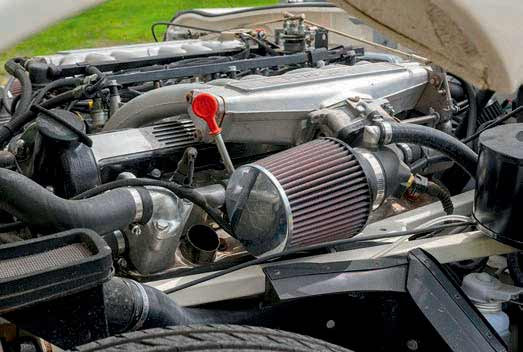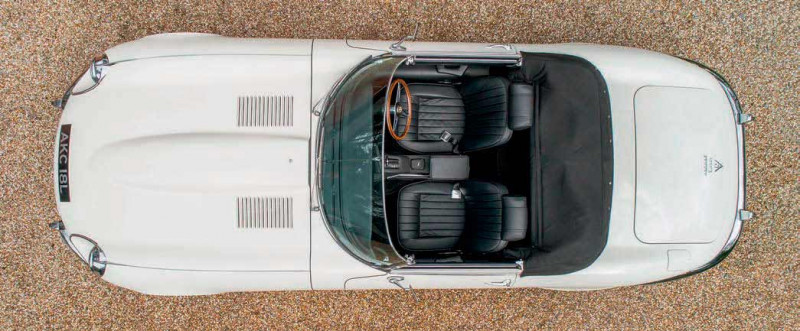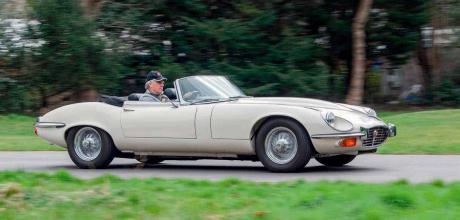Upgraded fuel injected 1971 Jaguar E-type Roadster V12 Automatic Series 3
Having been involved in the final specification of this usefully upgraded E-type V12, the new editor of Classic Jaguar finally gets to experience the fruits of his labour. Words: Ray Ingman. Photography: Matt Richardson.
BESPOKE V12 ROADSTER
LIFE WITH AN E-TYPE BUILT TO THE OWNER’S EXACT SPECIFICATION
FIT FOR PURPOSE A purpose-built E tested and reviewed with the owner
“...the suspension is surprisingly standard, proving that for a grand tourer, Jaguar was pretty near the mark”
It was back in 2018 that I was introduced to Anthony Cheng by a mutual friend. He needed assistance in sourcing an E-type to facilitate his long-held ambition to add the model to his collection. Having inspected some potential purchases on his behalf, however, it became apparent that despite appearances, all had shortcomings of one form or another when examined up close, as well as being too expensive to act as potential donor car for a restoration and major upgrade.

I then came to hear of a possibility owned by Jaguar specialist Tom Lenthall. A few years previously, he’d bought himself a matching-numbers Series 3 E-type, dismantled on several pallets as a project, the idea being that he and his wife, Meg, could share the car during that elusive time off. As is the way of business, however, customer work naturally got in the way of personal ventures and the car lived on the backburner.
Progress was slow, but that didn’t stop them from fully stripping the car down to its component parts and starting on the body. Fortunately, the bonnet was in such good, rust-free condition that it could be refitted with minimal repair. The bulkhead was also in excellent condition, with the only real work required being restricted to the usual vulnerable areas, including the outer sills, floorpans and the lower boot area; but it soon became apparent that the E-type would not progress any further. That, plus a hankering that Tom and Meg had for an XK150, made it easy for Tom to listen when Anthony expressed interest in taking on the E-type. A deal was struck and, as an effectively blank canvas presented itself, Anthony decided he would take the opportunity to have the car tailored to his precise requirements.
Between Anthony, Tom and myself, long discussion and debate resulted in the car we see today. Additionally, several workshop visits were made during the build process, not only to observe progress but also to attend to such seemingly minor but ultimately important details such as the precise location of the door mirrors in order to perfectly suit the owner’s stature. Attention to areas such as this can make or break the ultimate driving experience.

THE SPECIFICATION
The aim was to achieve a balanced coherent suite of modifications, all designed to produce a comfortable, entertaining and, of course, reliable long-distance tourer. For instance, there would be nothing to be gained by uprating the brakes beyond the grip of the tyres.
Externally the car doesn’t deviate far from standard, and at first glance neither does the interior aside from the addition of a Motalita AC Cobra replica wood-rim steering wheel, custom-made to fit a Series 1/2 boss to allow utilisation of the iconic early centre motif horn push. Further inspection reveals that Anthony eschewed any form of in-car entertainment; he reasoned that the car and its surroundings are entertainment enough. Hidden from view by the beautifully fitted black trim is a layer of Dynamat, expensive but effective in insulating the occupants from radiated heat and noise. And those familiar with the E-type will notice an XJ-S sourced automatic transmission shifter integrated into the centre console, hinting at what lies beneath.
The car was originally a four-speed manual, but for effortless touring Anthony reasoned that automatic transmission was preferable. He was dissuaded from fitting the original-equipment Borg Warner Model 12, deemed rather crude by modern standards. Instead, a GM400 was employed, fitted with a ‘shift kit’ to further sharpen its response. For long-term reliability, a ‘furnace brazed’ torque convertor was also fitted.

Turning to the chassis, the suspension is surprisingly standard, proving that for a grand tourer, Jaguar was pretty near the mark. Retaining standard Metalastik wishbone bushes, spring rates and shock absorbers, the car goes against received modifying wisdom – but remember, this car was specified for effortless long-distance touring, not the racetrack. Toyo Proxes C1S tyres in 215/65x15 dimension (compared to the standard 205/70x15) may seem like a conservative choice, but they integrate well with the suspension package and original brief.
Whilst running at factory ride height to minimise possible exhaust damage, the front torsion bars are set to give a very slight nose-down attitude to aid high-speed stability. A high degree of positive castor angle aids selfcentring, teamed with a standard rack and mountings, but with a selectively chosen stiffer internal torsion bar contriving to endow beautifully-weighted steering compared to most examples. The ‘turn in’ precision is further aided by the addition of a small amount of negative camber to the front wheels. The most radical departure from standard is the addition of front and rear Harvey Bailey anti-roll bars, conferring a high degree of roll stiffness but with no effect on ride compliance.

The brakes utilise standard calipers and discs, EBC pads, Aeroquip braided hoses and Castrol Super Response brake fluid, all combining to give a notably firm pedal with progressive action. The greatest deviation from standard is the employment of an Emerald engine management system. Tom Lenthall-modified 6.0 inlet manifolds and high-flow intake filters look after the air and fuel provision, while coil packs mounted within the ‘vee’ (not looking too dissimilar from the mass of HT wires above the standard distributor) deliver the sparks The ECU is discreetly tucked away behind the glovebox, integrated into the car with a neat custom-made loom.
Additionally, the Emerald system allows control of the uprated cooling fans, employing the standard engine temperature sensor reading, as opposed to relying on the often intermittent standard Otter switch located in the bottom hose assembly. The standard copper radiator was fitted with a high-performance core and filled with long-life coolant. Finally, to service the increased electrical demands imposed by the management system and uprated cooling fans and headlamps, the bulky and surprisingly modest (60amp) output Butec alternator was replaced with a modern 110amp upgrade.
DRIVING IMPRESSIONS
With Anthony stuck in Hong Kong since February 2020 due to international lockdowns and travel restrictions, he has had no access to his pride and joy. It was mutual friend Peter Sullivan who therefore met me recently at Anthony’s house, and as we entered his garage we were greeted by the sight of the magnificent E-type sitting exactly where it had returned from its latest pre-pandemic adventure some 18 months previously.
Removing the dust sheet, we noticed that the battery had been kept in tip-top order by the employment of a CTEK charger/conditioner. We added some fresh fuel to the tank, checked the levels and tentatively turned the key. After a few seconds, the fuel pump having primed, the engine burst into 12-cylinder life and settled to a fast idle. We allowed the long-immobile powerplant to warm through, using the time to check the tyre pressures and lower the hood. The engine management soon reduced the idle speed, in typical V12E fashion, with top-end engine noise radiating out of the louvres; it sounded ‘busy’ but a glance at the tachometer confirmed a smooth 600rpm idle.

So, what has the package of modifications achieved? Whilst not wishing to vie for the accolade of shortest-lived Classic Jaguar editor, I will confess to an affection for Alfa Romeos, particularly their petrol engines, be they V6 or twin-cam four. When driving one, the powertrain gives the impression of leaving nothing on the table – every horsepower and lb/ft of torque is immediately available for the edification of the driver. By comparison, I feel that all Jaguar V12 iterations – up to and including the 6.0 in both RS and factory specification – seem to hint at hidden inaccessible reserves of both qualities, none more guilty than the original Stromberg-carburettored, Opus-ignited V12E iteration. This car’s Emerald management system, however, addresses the issue in full, providing instantaneous throttle response with performance that seems linear up to the rev limit, with no hint of power peaks or ‘coming on cam’ along the way, all delivered with an urgency not offered by the standard specification.
The modified transmission responds to the accelerator in exactly the way a BW12 does not (bury throttle and go…), with part throttle downshifts seamlessly delivered by this analogue gearbox in a manner that hints of a far more sophisticated electronic unit.
The car tracks straight and true, unaffected by road camber and with no propensity to follow lorry ruts that lower profile tyres are often guilty of. It rides bumps smoothly with none of the clunks so often experienced in harder set-up cars. The anti-roll bars really come into their own when negotiating the left-right-left flick of a typical roundabout. No aspect of this car could be described as harsh, and the overall balance is such that you realise you haven’t really thought about it whist maintaining brisk progress.
Downsides? Very few. The continuous-whine fuel pump noise is slightly intrusive when paused in traffic with the hood up, particularly when compared to the gentle tick of a standard SU double pump. The seats cannot be described as supportive (the lack of upper body and head restraint is most noticeable when compared to modern seats) but they are subtly comfortable in a way that suggests long journeys could be achieved with a minimum of fatigue The custom-made mohair hood is tightly fitted, resulting in minimal wind noise and not necessitating the occupants’ voices to be raised at any speed up to (and slightly exceeding!) the national limit.
As part of our extended road test, designed to fully exercise the car pending Anthony’s return, we did not carry out any specific performance measurement, but notable was the fuel gauge’s lack of movement that’s usually a feature of spirited driving, the Emerald system appearing to provide economy in tandem with improved performance.
In chatting to Anthony (still stuck in Hong Kong) after my experience with the car, he was effusive in his praise for the E-type and the standard of Tom Lenthall’s work.
Since its recommissioning, this thoroughly reworked machine has proved to be totally reliable, with no issues whatsoever arising… a state of affairs at variance with Anthony’s early Jaguar recollections. When asked, with the benefit of hindsight, whether there’s any aspect of the E-type he would have specified differently, the answer was swift: “Nothing at all”. That, surely, has to be the ultimate compliment to all those involved in this car’s rejuvenation.
THANK YOU
We’re indebted to Anthony Cheng, Peter Sullivan and Tom Lenthall (tel 0118 973 7779, www.tomlenthall.co.uk) for making this feature possible in difficult circumstances
“...instantaneous throttle response with performance that seems linear up to the rev limit, with no hint of power peaks”
“...there would be nothing to be gained by uprating the brakes beyond the grip of the tyres”
OWNER’S EXPLOITS
Anthony grew up in Hong Kong, his affinity for the Jaguar marque going back to his father owning a succession of ‘Mk1’, Mk2 and XJ models. His recollection was that they were all somewhat unreliable and had a propensity to overheat, but nevertheless he developed an affection for their charms. Moving to London for work, in 1984 he decided to treat himself to a secondhand sports car. Despite “drooling” over E-types, he couldn’t shake off his childhood distrust and opted for the safe option of a Porsche 911SC Cabrio. The years passed and he gradually added to his stable of both modern and classic cars, all of which he enjoyed driving to the full. Then in 2018, Anthony finally decided to put past doubts behind him and purchase an E-type for the sole purpose of continental touring. Although he’s retained the car’s original manual gearbox for potential future use, Anthony’s wife, Mona, has warned him never to refit it – and interestingly, he wholeheartedly agrees. His other regular manual-transmission ‘touring’ cars (which he considers to be “icons of their eras and countries”) comprise a 1966 Aston Martin DB6 Vantage and a Ferrari 365GT 2+2, both of which are quite involving in their natures. The different charms of the automatic E-type see him using it in preference thanks to its comfortable, effortless, stress-free demeanour.
Anthony managed to use his newly completed E-type to the full in 2019, embarking on two major tours coordinated by V Management. May of that year saw him embarking on an epic tour from Split, Croatia, encompassing the spectacular and challenging D25 road from Gospic to Karlobag, crossing the Dolomite mountains (where temperatures ranged from sub-zero to 25 degrees C) and finishing in Sienna: “The E started and ran perfectly in all elevations and never missed a beat”.
Five months later, the second tour departed from Florence, again through mountains to Passo della Futa. It took in a few laps of the iconic Fiat test track on the roof of the Ligotto building in Turin, and then it was on to San Remo and Portofino, finally ending in Cap Ferrat in the south of France. It was serious touring, with many happy memories for Anthony: “Driving through a particularly winding uphill narrow country road in Croatia, a Ferrari 488 owner complained he couldn’t keep up with me! I guess his 488 was too wide and the corners were too deep. The E-type took the corners very well. It must be due to the modifications you recommended.”
Apparently, despite the exotica that the E-type was sharing the tours with, it attracted a disproportionate amount of public attention at every stopover. And not once did it have to “knock on the travelling mechanic’s door”, says Anthony… leaving that to a fellow tourer in a Ferrari 330.
“The greatest deviation from standard is the employment of an Emerald engine management system”
“...the suspension is surprisingly standard, proving that for a grand tourer, Jaguar was pretty near the mark”


